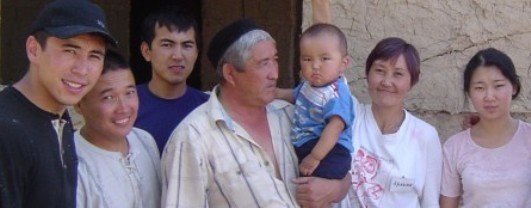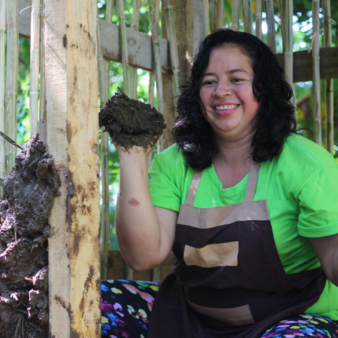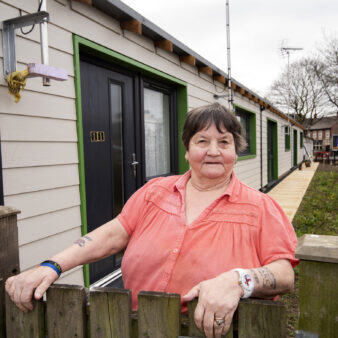Developed by Habitat Kyrgyzstan Foundation, this housing project provides affordable, environmentally-sustainable homes for low-income families using a traditional cane reed and clay construction technology, combined with an innovative coiled circuit under-floor heating system. The houses are seismically stable and meet local building codes. This technology allows families to save up to 40 per cent on construction costs compared with the cost of conventional brick housing construction and up to 75 per cent in energy costs. Forty-eight houses have been built to date, using self-build and volunteer labour to reduce costs. Low-cost housing loans help to ensure affordability.
Project Description
Aims and Objectives
To provide an affordable, environmentally sound, seismically stable and transferable housing and heating solution for low-income families in Kyrgyzstan.
Context
With a population of 5.4 million, Kyrgyzstan is one of the poorest countries of the former Soviet Union. Approximately 70 per cent of the population lives in substandard housing conditions, in dormitories, on the streets or with relatives and friends. In the last five years the population of the capital, Bishkek, has grown from 800,000 to 1.5 million, as low-income families from rural areas have moved to the capital city in search of shelter and employment. The capital is overcrowded and in dire need of decent, affordable housing. Nearly 700,000 people live in new housing estates on the outskirts of Bishkek, without access to basic infrastructure, and it is not unusual for three generations to be crowded in a single room with no heating or running water.
Building a home in Kyrgyzstan is expensive, as is heating a home, and during the harsh winters families spend up to 50 per cent of their income on heating. Traditional solid fuel heating, used by 80 per cent of the population, is cheaper than electric heating but is inefficient, in addition to polluting the air and contributing to deforestation and the depletion of coal reserves. Women and children spend hours each day gathering firewood and the need to heat the house and still have enough to eat supersedes any awareness families may have of the physical risk and environmental impact of solid fuel heating. Kyrgyzstan consumes more coal, oil and natural gas than it produces; at the same time, local electricity production is considerably higher than current consumption. The country’s relatively new energy development programme aims to reduce energy loss, introducing energy saving technologies and taking measures to fight pollution and address climate change.
This project has been developed by Habitat Foundation Kyrgyzstan (HFK) to tackle the issues of substandard housing conditions, the misuse of energy resources, dependency on imported energy and lack of affordability, both in terms of housing and of heating costs.
Key features
This project provides affordable, environmentally-sustainable housing for low-income families in Kyrgyzstan through the use of a traditional cane reed and clay construction technology, combined with a coiled circuit under-floor heating system. This technology allows families to save up to 40 per cent on construction costs compared with the cost of conventional brick housing construction and up to 75 per cent in energy costs. The heating system is clean, energy-efficient and environmentally friendly, as well as simple to use, secure and easy to install.
The approach encourages the utilisation of locally available resources and the revival of a traditional cost-effective building technology commonly used in the 19th century, but forgotten in the 20th. HFK has adapted the traditional cane reed construction method to include a timber frame with cane reed and clay wall sections, resulting in improved insulating properties, earthquake resistance and compliance with local building codes.
The cane reed and clay technology is used in the floor, walls and ceiling. Wall sections are secured to the timber frame and plastered with a waterproof, cement-stabilized plaster. All materials used are locally available. The floor consists of the foundation walls, containing a layer of gravel, a layer of clay and cane reed wrapped in a protective plastic, a reflective plastic/foil membrane, the insulated multi-layered plastic water heating pipes coiled throughout the floor and the final concrete screed. The coiled circuit under-floor heating system is ‘sandwiched’ between the slabs of reed and clay and the final concrete floor slab. The 1cm-diameter polythene water pipe is coiled throughout the floor of the entire home, spaced at 12cm centres, ensuring an even distribution of warmth throughout the home. The system uses a 3.4kW circulating pump and the water heater tank has a capacity of 10 litres. The combination of narrow diameter pipes, reflective foil and reed insulation maximises heat conduction and minimises the volume of water needed for the circuit (30 litres in total) without compromising the quantity of heat produced and circulated.
Habitat families take on the responsibility of purchasing their home with a long-term, zero-percent mortgage and commit to building their home along with other volunteers using the traditional ‘ashar’ mutual-help method. Each family contributes approximately 500 hours in labour and working in collaboration with local and international volunteers. Home designs are carefully developed to make use of local materials and to be ‘volunteer-friendly’ so that they can be constructed almost entirely by the residents and volunteers. To ensure equal standards in build quality, families do not know which house will be theirs until the building process is complete. Each family is then responsible for the ongoing management and maintenance of their property. Houses can be built in as little as three months and the Habitat staff, families and volunteers work together to form a supportive, integrated community.
Covering costs
The costs of the project have been met through labour and in-kind donations from residents and local government. Funding has also been obtained from international organisations and donor agencies. Winning the Global Development Marketplace competition in 2006 led to a grant by the World Bank which has been used to construct ten additional cane-reed houses. Some core funding has been provided by Habitat for Humanity International, but HFK conducts its own fundraising and outreach programmes in order to fund projects and cover some of its operating costs. HFK has developed a partnership with government agencies and land is often obtained free of charge from the local government with the understanding that the land is to be used as a part of a community development programme.
Residents’ monthly mortgage repayments and donor contributions are put into a revolving fund which is in turn used to develop new projects and build more homes for low-income families in the country. The zero-interest mortgage loans provided to families are repayable over a period of 10-25 years at a rate of US$30-50 per month.
Impact
- In post-occupancy studies carried out by HFK, families reported improved living conditions and increased self esteem from living in a decent home. Children are able to concentrate on schoolwork in comfortable living conditions, health has improved due to better indoor air quality, homes are warm during the harsh winters and energy and running costs are greatly reduced.
- Construction with the cane reed and the use of the under-floor heating systems has reduced the impact on the environment.
- In comparison with conventional housing, construction costs have been reduced by 40 per cent and heating costs by 75 per cent.
- Local and international volunteers taking part in the project are able to gain skills through the construction process as well as taking back lessons to their own countries and contexts.
- HFK has developed a strong partnership with government agencies, receiving support from the City of Bishkek (donation of land and provision of infrastructure) and the Architecture and Construction Committee (regularising land, providing technical and design assistance and facilitating the necessary permits).
Why is it innovative?
- The project involves a combination of a traditional building technology (cane reed and clay) with a new one: the innovative coiled circuit under-floor heating system. Through this combination, HFK has achieved both low construction costs and low maintenance and heating costs without compromising the structural integrity of the home.
- In comparison to conventional housing, this low-cost construction system has improved insulating properties, is seismically stable, meets local building codes and has a reduced environmental impact
- HFK has developed an innovative way of laying the floor and heating system in one step, and the under-floor heating system uses extra-thin locally-produced pipes, thus minimising the volume of circulated water.
- HFK is the only organisation in the country providing zero-interest mortgages. Monthly mortgage payments are put into a revolving fund which is then used to build more homes for low-income families.
What is the environmental impact?
Kyrgyzstan experiences extremely harsh winters and hot summers and cane reed offers better insulation than brick. This keeps heating and cooling costs down, which translates into energy savings as well as cost savings for the family. The electric under-floor heating system only requires 30 litres of water to heat the entire house and applying the combined technology of cane reed houses and the effective floor heating, communities can save up to 3000 KW/month/family. This contributes towards a reduction in the dependency on foreign solid fuel sources and reduces pollution.
The cane reed used in the house construction is a locally produced, renewable resource. Harvested annually, reeds sustain life in ponds and lakes; their roots also stabilise the surrounding earth, preventing soil erosion. The use of the reeds also reduces dependence on, and misuse of, forests. Other building materials used in the process are sourced locally, including the pipes used in the under-floor heating system, which are produced locally by a partner company.
Is it financially sustainable?
The revolving fund established through the programme ensures the financial sustainability of the project. Through a combination of financial contributions from international and local donors and homeowners’ monthly mortgage payments, the fund has grown year on year, allowing for an increasing number of new homes to be built and projects developed. HFK continuously seeks other forms of support and funding, through NGO partnerships, grants and sponsorships.
The project invests in the local economy by employing a community labour force to harvest the reeds which are woven into the timber frame, as well as gathering the clay, sand and mud used to fortify the reed. In some cases, residents have been able to obtain permanent employment as a result of the training received during the construction process. One example is a former doctor who, following the project and facing financial difficulties in the changing economic situation, decided to open his own private construction firm and now works in partnership with HFK.
The cane reed technology increases affordability as it offers a 40 per cent reduction in housing cost compared with conventional brick housing. Families are involved in the construction process and the US$60 monthly savings on heating costs allows families to comfortably make the interest-free mortgage payments of US$30-50.
Families taking part in the project are selected on the basis that they are unable afford conventional housing but have sufficient income to afford the monthly payments and other costs associated with homeownership. Each household must have a per capita income of less than 75 per cent of the community average per capita income, but no more than 40 per cent of a family’s monthly income should be spent on housing.
Plans are currently underway for the development of a Building and Training Centre where all construction materials to be used in Habitat homes will be produced, further decreasing the costs to participating families.
What is the social impact?
HFK works not only to build houses but also communities. A Family Support Committee has been set up to welcome new families into the Habitat family and provide them with a mutual support system, educational opportunities and a forum for discussions pertaining to Habitat homeownership. Families are trained before, during and after the building process, on issues that range from maintaining the household budget to building skills and house maintenance. This is further enhanced through the ‘ashar’ mutual help construction process itself which has not only enabled residents to get hands-on training in housing construction, it has also helped to facilitate greater cooperation and integration amongst the families involved in the project.
The Habitat programme is based on the principle of a ‘hand up’, not a ‘hand out’ and HFK has worked to reduce economic and social inequalities. As a result of the project, women in particular have reported improved living conditions, as they are no longer required to gather firewood, wash dishes and clothes outside by hand and cook in a confined space. They have time and energy to pursue work outside the home, therefore helping to increase household income. The reduction in the use of solid fuels has also resulted in decreased levels of indoor air pollution and has consequently improved health, with a particular fall in respiratory illnesses.
Families are encouraged to become leaders in the community by serving on Habitat committees such as the Family Support Committee and assisting with other construction projects.
Barriers
- During the construction of the first three cane reed houses in 2004, the greatest barriers faced included poor weather conditions during the building process, the search for a reliable cane reed supplier and the search for appropriate, locally produced materials, such as plastic pipes and boilers. HFK was able to find reliable local suppliers and contractors such as Chelebi, who were not only able to provide high quality materials at good value but were also willing to establish a long-term partnership with HFK, taking part in the development of new projects and providing technical assistance.
- Rumours about political instability and other risks such as avian flu may lead to international volunteers refraining from travelling to Kyrgyzstan to take part in the project. In such cases, HFK works to keep volunteers informed of the situation and takes steps to reduce the risk by involving more local volunteers in the process.
- The changing political situation in the country has led to changes in local authority personnel and a lack of continuity. In some cases it has therefore been necessary to allow more time for the obtaining of necessary documents and permits.
Lessons Learned
- The lack of reliable suppliers can jeopardise any excellent initiative, as was the case during the construction of the first three pilot houses in 2004. Having subsequently established a solid relationship with the cane reed supplier and securing technical support from local contractor Chelebi, the next nine houses were built within three months.
- The combination of traditional and modern construction methods does work! HFK intends to continue to find new housing solutions and work to revive and/or adapt traditional construction methods.
- Environmentally-friendly heating systems do not necessarily have to be expensive to install and/or maintain.
- It is important to allow sufficient time to obtain the necessary permits and have a contingency plan in the case of a crisis.
Evaluation
Habitat Foundation Kyrgyzstan regularly monitors its projects and interviews homeowners. Key findings of a recent evaluation study showed positive results, with average savings to families of US$60 per month in heating costs, average room temperatures of 18-20° during the winter, good maintenance levels, high user satisfaction rates with housing design and thermal performance and greater integration between families as a result of the mutual help process.
Transfer
In addition to the 48 cane reed homes, the under-floor heating system has been applied to existing housing stock in Kyrgyzstan through other HFK projects. The organisation is planning to build its first-ever multi-apartment complex for ten families using the cane reed technology and under-floor heating system on land donated by the City of Bishkek.
The Kyrgyz government have expressed an interest in transferring the combined cane reed construction technology and under-floor heating system to other areas. The approach is currently being transferred to the neighbouring country of Tajikistan. Partnerships have been established with two Tajik organisations and the first demonstration projects are due to be built in Dushanbe and Sahrtuz in 2008.
The construction methods used in the cane reed construction and under-floor heating systems are simple, inexpensive and easy to learn and there is strong potential for transfer of the approach to other countries and contexts where cane reed and timber are available.
HFK is currently in the process of scaling up its activities: last year the organisation worked with 80 families, in 2007 year they will be working with a total of 400 families and in 2008 the organisation is planning to work with an additional 800 families, introducing new projects and extending their work to other parts of the country. This work will include a combination of cane reed construction (a minimum of 15 homes per year through 2009), renovation of prefabricated apartment buildings and home improvement/completion projects. Approximately 50 per cent of the costs for new projects will be covered by the revolving fund and additional funding will be obtained from a range of sources, including donor contributions and residents’ savings.



